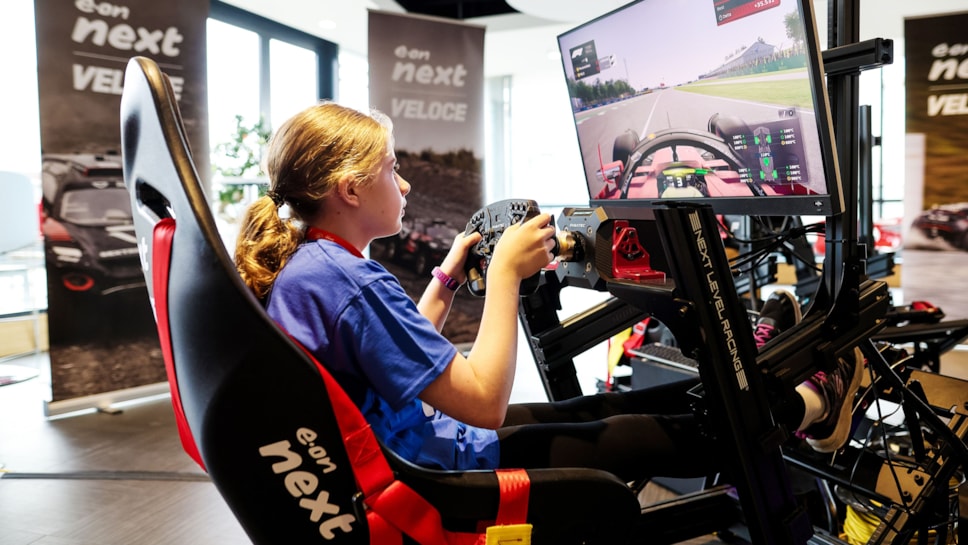
From virtual to reality: how gaming is shaping the next generation of drivers at Veloce
Jack Clarke, Chief Strategy Officer at E.ON Next Veloce Racing, explains how gaming is breaking down barriers in motorsport, helping to discover and nurture the next generation of diverse, talented drivers - from virtual simulators to real-world tracks.
Motorsport is a playground where accessibility is truly put to the test. It’s expensive to run any car, let alone a car at Formula 1 level, so this is a huge barrier to entry for so many people. The key is to find the future drivers at a young age, nurturing their potential before the financial obstacles become insurmountable.
Part of our vision at Veloce has been to embrace the virtual world – and by embracing this world, we can reach far more potential motorsport stars than we ever could have before.
We’re constantly trying to break down those barriers to accessibility.
Our dream has always been to guide these young talents on their journey, starting from the ultimate point of access - they sit down on our simulator, take a shot at setting a fast lap, and prove to be quicker than everyone else — regardless of gender or background – because the barriers to entry are entirely different in this virtual space. From there, they can rise through the ranks.
Similarly in our work with E.ON Next, where we’ve gone out to a number of schools across the country as part of our Kids in Motorsport days – reaching out to children and young adults who would typically never get that opportunity to imagine a future career as a racing driver or in the wider motorsport world. It’s during events like these where we’re able to really find that raw talent – that innate aptitude – that, with nurturing and the right environment, could lead on to prosperous careers in the motorsport industry.
The simulators we use across our event days, along with our BATAK response game, are excellent indicators of potential on-track performance. They’re the first box to tick. As a former racer and father of three, I can tell which one of my children has a natural aptitude so from experience you can spot a child's natural aptitude for certain skills from these early entry points.
Opening opportunities for all
When you’re young, most kids kick a football at some point, or you know that one person at school who’s exceptionally fast at running. But how many kids have the opportunity, or the access, to get behind the wheel of a go-kart and prove they have the skills on track? That’s why as a business we genuinely try to shake things up and create that access.
And gaming not only helps us tap into people who wouldn’t usually have access to motorsport, but it also allows us to connect with a group that has been historically under-represented: women.
When you extend that access to women and girls, it obviously expands your talent pool. For us, staying ahead of the competition means tapping into that other 50% of the population we haven’t yet reached.
There’s also a significant number of people who don’t have access to go-karts or the traditional ladder required to climb up in motorsport and that’s where the gaming revolution has been a pioneering force for businesses like ours. Gaming allows us to establish ourselves as innovators in the sport. What’s groundbreaking about this approach is that it uses technology to create access for everyone, particularly for those who haven't always had the same role models — people like our own Molly Taylor or Jamie Chadwick — to look up to. By levelling the playing field, we're not just finding the next generation of drivers, we're shaping the future of motorsport.
From virtual triumphs to real-world success
The impact of gaming in motorsports is more than just a theory, it’s already being proven on some of the world’s biggest stages. The 2020 24 Hours of Le Mans Virtual, for example, is a perfect case in point. Held as a substitute for the real-life event during the pandemic, it brought together professional drivers and top gamers in a simulated version of one of the most challenging endurance races. The event highlighted how virtual racing can mirror the demands and pressures of real-world motorsports, further solidifying the value of gaming as a training ground for future talent.
A similar and equally compelling example is the story of Jann Mardenborough, who transitioned from a Gran Turismo gamer to a professional racing driver. Mardenborough’s journey from his PlayStation console to the podium at Le Mans showcases how gaming can not only identify raw talent but also prepare individuals for the realities of professional motorsport. His success is a testament to the idea that gaming is not just a hobby—it’s a legitimate route to a racing career, breaking down barriers that once seemed insurmountable.
By integrating these virtual platforms into our talent discovery process, we are not only expanding our reach but also ensuring that the next generation of drivers is more diverse and inclusive than ever before. The future of motorsport is as much about the digital world as it is about the physical one, and at Veloce, we’re at the forefront of this exciting evolution.


